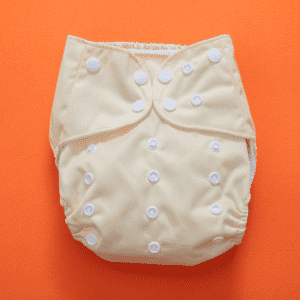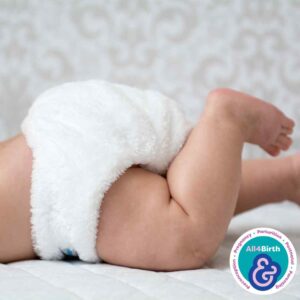Life with cloth nappies – Real Life Story
Fatimah Mohamied (Registered Midwife)
Before babies
The anti-natalist argument is that it isn’t ethical to bring new human beings into a world that is steadily becoming inhospitable to human life. I felt this way when pregnant with my eldest daughter, and when I expressed my feelings to a friend, the response I was succinctly given was “But we can’t end the human race, we need a generation of hope to change things”.
My environmental consciousness began many years before I fell pregnant, due to religious beliefs that caring for our planet is one of the reasons we exist upon it. Hence, I had been making small steps to lessen my harm to the planet and its inhabitants. I did this by buying clothes only when I needed them, purchasing fruit that was in-season, and only consuming meat once a month. However, when I fell pregnant, I realised that very little surrounding babyhood and parenting was sustainable, in fact, the excitement of expectant parents seemed to have been hijacked by corporations as a marketing tool to heighten consumerism as much as possible.
Expecting babies
A common theme I heard growing up was that having children is expensive. And when I visited the Bank of England Museum recently, and discovered the average cost of raising a child for 21 years was over £250,000, I found it hard to disagree. But I was stubborn, and became determined to make having a child as cheap as possible.
The amalgamation of my environmentalist activism and need to pay rent, made cloth nappies a natural conclusion. This is because using cloth nappies eliminates the need to continuously buy disposable nappies that would otherwise remain in a landfill site for two hundred years, making cloth nappies in the long term, a much, much cheaper solution, especially as they can be used for multiple children.
An argument against the ecological and financial benefits of cloth nappies, is that they require more use of a washing machine. My rebuttal would be to ask to meet a parent that doesn’t use their washing machine more now, than they did prior to parenthood. Besides, if you simply wash the nappies with the baby’s clothes as I do, then you save time and energy.
A question of money
The difficulties of acquiring cloth nappies isn’t lost on anyone. Capitalism thrives off poorly manufactured goods which maintain a cycle of consumerism that the people from lower socio-economic backgrounds often pay the most for. Paying for higher quality goods remains unaffordable for many, and this enables capitalism to perpetuate poverty by forcing those less well-off to continuously buy low quality goods, more frequently. This formula also applies to childrearing and can feel inescapable.
Buying cloth nappies requires a large upfront cost, though this can be decreased significantly if they are bought second hand. I use the term second hand and not preloved deliberately, not in the least because no-one loves nappies and because I don’t believe there is any shame in acquiring something previously used by someone else. In fact, I would say there should be pride and an accompanying prestige in reusing an item for its entire lifespan. When it has felt incredibly difficult, I always revert to the fact that cloth nappies are an investment, and giving up on them is akin to giving up money and giving up on the health of the planet. This has also kept me on the path of exclusively using non-bio detergent.
The right number
I am very fortunate to have been able to afford the upfront cost of acquiring 25 cloth nappies. I initially bought 15, which was certainly not enough because my firstborn arrived in winter, and her cloth nappies taking a long time to dry indoors was a stressful experience. I made do with 5 more, but when my second daughter was born, an extra 5 really helped me manage my time better with two small children and a self-multiplying laundry hamper. However, my second child was born in summer, which made drying the nappies much less time and energy consuming.
The season is important when negotiating plans around cloth nappies, because a baby requires the most frequent nappy changes when they are a newborn (on average 10 nappies a day), and this steadily dwindles as they get older. This means that washing frequency is highest when a child is born, but it isn’t the washing that is hard, it’s the drying. This is because spare nappies are required for use while waiting for the dirty nappies to be washed and dried. Depending on your method of drying, this could span between two days and two hours. A catch-22 arises as the more nappies you wash, the longer they will take to dry. Hence all these nuances need to be balanced when contriving a cloth nappy system: there is often a lot of trial and error when a couple transition into being a family for the first time, and it can be a time that is fraught with difficult adjustments, sacrifices, and steep learning curves.
Safety first
Babies that are exclusively breastfed do not have smelly nappies or stools, but storing them in a lidded container while they are waiting to be washed is advisable. Soiled nappies do not need to be pre-treated and can be chucked into the washing machine without fuss. When solids commence so do the smells! A stool will need to disposed of in a toilet before a nappy can be washed, but no stains no residual smells occur.
However, with repeated washing cloth nappies retain residual detergent, which reduces their capacity for absorption and can cause nappy rash. Strip washing (where cloth nappies are washed once or twice in the washing machine without detergent to strip them of residual soap) them once a month evades these effects.
The light at the end of the load
Yes, using cloth nappies can initially be hard, but when you develop a system of washing and drying, and begin to unconsciously plan your days around laundry, they get easily incorporated into your routine. Now the idea of throwing a nappy into a bin, especially one with poo in it, feels unsanitary — that’s how seamlessly cloth nappies integrate themselves into your life.
Laundry is an inevitable part of life with a child, whether you use cloth nappies or not. So, I believe it’s worth the time to do a little more to save some money and perform mutual aid for the sake of the planet, and our children’s future. Moreover, even if a family uses one cloth nappy, it is one less disposable nappy used, which ultimately is a win for collective action.










